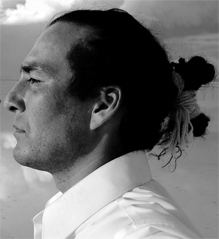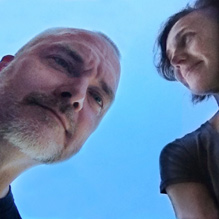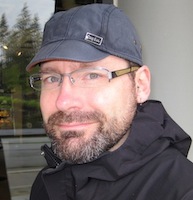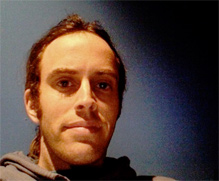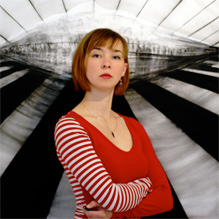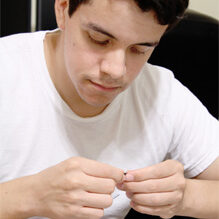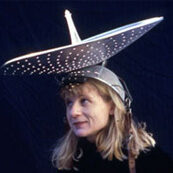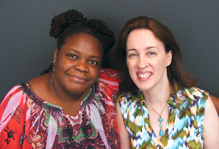Integrating Art, Science, Technology and Indigenous Knowledge
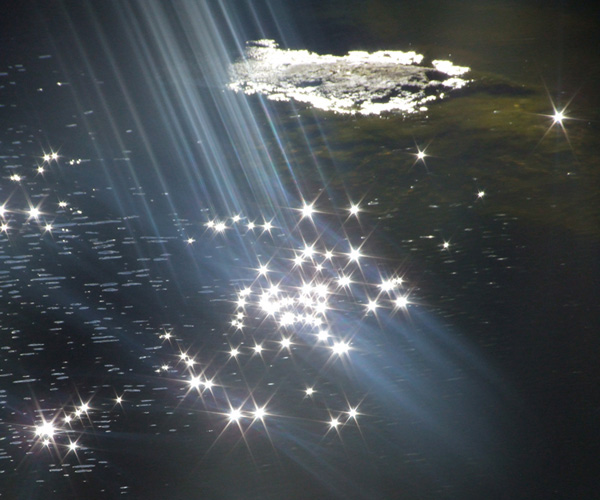
Photo by Jo Tito
The “Wai” (Maori for water, flow) project connects Maori cosmology, notions of integrated systems, and Western art and science in order to reinvigorate our understanding of flow and water across cultures and disciplines. It includes installation and video components, using technology to focus on the urgent need to engage with sustainable practices, given the environmental crisis. It covers the subjects of energy, ocean acidification, and Maori and Diné (Navajo) approaches to water. Text panels are quad-lingual and include Maori, Spanish, Navajo, and English.
Te Hunga Wai Tapu: (the group of people for whom water is sacred): This art project illustrates the principle of Wai, a Maori concept that is best expressed as water or flow. In the Maori worldview, water or Wai connects people to mountains, rivers, the air and birth. Wai both contains and exercises power, just as energy can be modeled both as force fields and as moving particles. The Maori values of respect for nature and sustainable practices aim to ensure that energy flows in ways that are useful and healthful for the planet. This project has an engineering/electronics component where data sensors in New Zealand control audio of traditional Maori and Navajo instruments, heard in Albuquerque. Following Ohms Law, the artists can utilize the ability to resist electrical energy flow as a means to creatively control by simple processor programming, the behavior of elements of an integrated electrical circuit composed of sensors and output modules such as audio and LED. Being able to output data to the internet allows the artists to add an additional modulation in terms of audio output. That has allowed a further layer of creative framework.
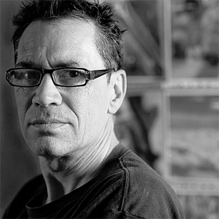
Te Hunga Wai Tapu
I’m Ian Clothier and I am part of a collective project called "Te Hunga Wai Tapu." I live in New Zealand Aotearoa. I’m a hybrid Polynesian, with family lines going back to Norfolk, Pitcairn and Tahiti. My fathers line goes back to the Shetlands and to the Vikings. I’m very much interested in connecting diverse things together. I believe we are all part of one whole, stretching from the smallest living things to individual people to the universe.
Skills Applied
 OHMS LAW
OHMS LAW
 PROCESSING PROGRAMMING
PROCESSING PROGRAMMING
 INTEGRATED ELECTRIC CIRCUITS
INTEGRATED ELECTRIC CIRCUITS
 AUDIO AND LED OUTPUTS
AUDIO AND LED OUTPUTS
ARTIST SUGGESTION
One thing students could do, is start by deciding to work with someone from a different culture, and then talk about what is similar or different, seeking connecting points. Another thing they could do is to take simple technologies like LED’s and try to work out ways they can be incorporated into art works. It is fairly straightforward to program LED lights to flash in patterns. You basically tell the LED when to turn on and when to turn off. The creative becomes which pattern to use and why. One of the works in the show is called a Pou Hihiri, and it has imagery and LED’s. Students could make a work inspired by the Pou, which was made under the direction of Te Urutahi Waikerepuru. It connects traditional Maori knowledge with electronics. Ian
Stemarts Design Tool
Explore the site to come up with your idea. Pick an artist or topic.
This artist is one of 20 ISEA2012 artists featured in this curriculum. Explore them all to see which you would like to use as a model for your project. It could be a combination of different artists and topics that inspire the work. Print out the STEMArts Design Tool which outlines these steps and use it as a guideline in your process. Visit the Wiki-Resource on each artist page to see tutorials, activity ideas, read articles about the medium that the artists explored and other resources to help you find something that peaks your interest. Click on the Artist Interview button on each page to read a personal interview with each artist. The artist was asked questions to share their creative process, talk about the medium they work with, and to share tips and advice for you as you begin your design process. In this phase, you are looking for inspiration for an project that is meaningful to you. Get a journal and start sketching and writing notes on your process.
Brainstorm and come up with ideas for your art piece.
In this phase, you will need to sketch, doodle, contemplate, or journal, in order to start allowing ideas to formulate. Search the Wiki-Resource under keyword “brainstorming” to explore some techniques and articles. The artists in the Artists Interviews also share their personal brainstorming techniques. Read through all these resources and do some research yourself. Then set aside some daydreaming time and get started. Think big and let all the ideas you have hit the page without editing them. Get in the flow and write or draw in a journal any ideas you come up with that you would like to explore further.
How are you going to turn the idea into a reality? Research.
Brainstorming and researching go hand in hand. You will be going back and forth between the two until you come up with a plan. Once you brainstorm some great ideas for an art piece you will need to research to learn more about the topic or medium. In turn, that leads to more brainstorming. How are you going to turn the idea into a reality? What materials do you need? Can you build it yourself or will you need help? In your journal make a list of any questions or concerns that come to mind. Search the Wiki-Resource under the keyword “research tips” for ideas, and explore on your own to find the answers to your questions. If you need to collaborate on this piece, decide who that will be and make plans to work together.
Start your design plan.
You have everything you need now to start creating. Refer to your journal to review your process up until now. Review the STEMArts Design Tool. Research online if you still have a question about anything. Ask your teacher for help. Now, it´s time to make a materials list and sketch out your plan of action. Or perhaps you prefer to dig in and start building something? There are many ways to approach it and every artists has their own style. Each artist shared their own design approach in the interviews. Look back over them and see which approach suits your style. Start creating!
See how it works, test and re-test until you get what you want.
The design process always involves testing out your ideas in the real world, and building prototypes to see if it works. You also may find that once you start building it, it is not what you had in mind. This is part of the process. It helps to document everything you do in your journal. This is the hardest stage because it is easy to get discouraged. Read about what the ISEA2012 artists say about this phase. Ask for help when you need it. If you get stuck, go back to the brainstorming phase for new ideas. Get feedback from your teacher, your friends, and experts. We created a Troubleshooting Guide to help you evaluate and critique your work in case you are stuck on your design.
Practice presenting in order to get feedback for your finished piece.
You have probably explored options for presenting your work but this is the time to work out the details. Your venue will often determine the presentation format. Now is a good time to present your work to friends and peers to get some feedback. Our Feedback Survey poses questions that will help you critique your own work, and provides tips on receiving constructive feedback from others. It will also help to look back on your design process to see if you are where you want to be with your art piece.
Bringing it all together. Time to share it.
Sharing your work can be scary and thrilling at the same time. Hear what artists have to say about the importance of sharing their work with the public. Do you want to share it in your community? Is there a venue interested in what you have created? Will you use Vimeo, YouTube, a blog? Search under keyword “Share tools” in the Wiki-Resource for some links and ideas.
STEMarts Wiki
Search this open source wiki for links to learn more about the type of art, medium and STEM topics explored in the Wai project. We suggest starting with the featured activity Water Aware portfolio lesson, which will help you explore the idea of water.
You will also find links to articles, images, video, tutorials and more to provide a starting point for your research in creating an art piece or project inspired by the Wai project. If you have find anything interesting on your own please consider sharing it in this open forum.
Remember the resource is an open forum sharing links and ideas that others have found – always check your sources and give credit where credit is due. The open source movement generously shares its knowledge and relies on users and sharers feedback – so if there’s something really good or doesn’t work let others know.
Activism Activist Art Artificial Intelligence Artists Residencies Artivism Bio Art body-art Contemporary Science Conversations Cultural Economy Culture Jamming Eco Art Education Environmental Art Hacktivism Integrated Systems Intelligent Machines Interconnected Interconnected world Interdisciplinary creativity Land Art Network Art Public Art Renewable technologies Social Networks Solar Powered Artwork Sustainability Sustainable design Systems Thinking video VIEW ALL
NEXT GENERATION SCIENCE STANDARDS
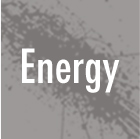
Core Idea PS3: Energy
PS3.A: Definitions of Energy
PS3.B: Conservation Of Energy and Energy Transfer
PS3.C: Relationship between Energy and Forces
PS3.D: Energy in Chemical Processes and Everyday Life

